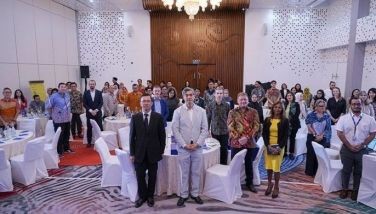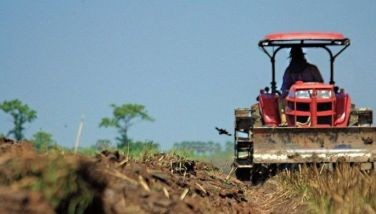Better alternative to sun drying developed
November 19, 2006 | 12:00am
A better alternative to sun drying for small scale food processors has been developed by the BPRE (Bureau of Postharvest Research and Extension), which is based at the Science City of Munoz, Nueva Ecija.
Called the MCSTD (multi-commodity solar tunnel dryer), the new invention is particularly useful for small scale food processors who need to dry their products but can hardly afford to buy commercial mechanical dryers, especially now with the increasing cost of electric energy.
Moreover, food products dried by sun drying are of poor quality and not acceptable for export. This is because dust accumulates on the products while these are being dried, especially if the drying process is done along the highway as practiced by small scale fish processor-vendors in Damortis, La Union.
What’s more, microorganisms also accumulate on the products during drying. Thus, the dried products do not meet quality standards.
BPRE engineers patterned the MCSTD after the solar tunnel dryer that was developed earlier at the Hohenheim University in Germany.
BPRE executive director Dr. Ricardo L. Cachuela said the operation of the MCSTD is cheaper than locally available commercial mechanical dryers.
The MCSTD dries commodities like fish, fruits and vegetables efficiently and hygienically. It also preserves the dried products longer because of lesser microbial content. Likewise, it allows a ready supply of dried products even during lean months and uses locally available materials to suit the needs of farmers and fisherfolk who put added value on their products through processing.
Cachuela said the MCSTD can be easily fabricated using locally available construction materials. Its modular design allows easy transport and installation. It has three major components â¤" heat collector, drying chamber, and axial fan or blower driven by an electric motor.
The heat collector and drying chamber are covered by ultraviolet-stabilized polyethylene plastic sheet mounted on an inverted "V" metal frame. The product to be dried is spread evenly on the trays provided inside the drying chamber, which are made of 4 mm iron bars. The axial fan forces air into the heat collector, which increases the air temperature in the drying chamber to as high as 60 degrees Celsius.
It takes a much shorter time to dry fish products than traditional sun drying. Drying trials revealed the following drying time: alamang or soft shrimp (62.4 kg), four hours; espada or hairtail (41.6 kg), four to five hours; danggit or barangan (55.8 kg), seven hours; dilis or anchovies (52 kg), six to eight hours; and posit or squid (40.3 kg), five to six hours.
The MCSTD is now being used for processing tilanggit (dried small tilapia named after tilanggit) in Brgy. Palacian, Aglipay, Quirino province. Mrs. Vilma Joson, who heads a cooperative of rural women, is also using the MCSTD for processing tilanggit. In Ilocos Norte, the Office of the Provincial Agriculturist, led by Norma Lagmay, is using the MCSTD for drying mangoes, camias, tomatoes. – Sosimo Ma. Pablico
Called the MCSTD (multi-commodity solar tunnel dryer), the new invention is particularly useful for small scale food processors who need to dry their products but can hardly afford to buy commercial mechanical dryers, especially now with the increasing cost of electric energy.
Moreover, food products dried by sun drying are of poor quality and not acceptable for export. This is because dust accumulates on the products while these are being dried, especially if the drying process is done along the highway as practiced by small scale fish processor-vendors in Damortis, La Union.
What’s more, microorganisms also accumulate on the products during drying. Thus, the dried products do not meet quality standards.
BPRE engineers patterned the MCSTD after the solar tunnel dryer that was developed earlier at the Hohenheim University in Germany.
BPRE executive director Dr. Ricardo L. Cachuela said the operation of the MCSTD is cheaper than locally available commercial mechanical dryers.
The MCSTD dries commodities like fish, fruits and vegetables efficiently and hygienically. It also preserves the dried products longer because of lesser microbial content. Likewise, it allows a ready supply of dried products even during lean months and uses locally available materials to suit the needs of farmers and fisherfolk who put added value on their products through processing.
Cachuela said the MCSTD can be easily fabricated using locally available construction materials. Its modular design allows easy transport and installation. It has three major components â¤" heat collector, drying chamber, and axial fan or blower driven by an electric motor.
The heat collector and drying chamber are covered by ultraviolet-stabilized polyethylene plastic sheet mounted on an inverted "V" metal frame. The product to be dried is spread evenly on the trays provided inside the drying chamber, which are made of 4 mm iron bars. The axial fan forces air into the heat collector, which increases the air temperature in the drying chamber to as high as 60 degrees Celsius.
It takes a much shorter time to dry fish products than traditional sun drying. Drying trials revealed the following drying time: alamang or soft shrimp (62.4 kg), four hours; espada or hairtail (41.6 kg), four to five hours; danggit or barangan (55.8 kg), seven hours; dilis or anchovies (52 kg), six to eight hours; and posit or squid (40.3 kg), five to six hours.
The MCSTD is now being used for processing tilanggit (dried small tilapia named after tilanggit) in Brgy. Palacian, Aglipay, Quirino province. Mrs. Vilma Joson, who heads a cooperative of rural women, is also using the MCSTD for processing tilanggit. In Ilocos Norte, the Office of the Provincial Agriculturist, led by Norma Lagmay, is using the MCSTD for drying mangoes, camias, tomatoes. – Sosimo Ma. Pablico
BrandSpace Articles
<
>
- Latest
Latest
Latest
March 4, 2024 - 3:32pm
By Ian Laqui | March 4, 2024 - 3:32pm
March 4, 2024 - 2:12pm
By Kristine Daguno-Bersamina | March 4, 2024 - 2:12pm
February 17, 2024 - 2:31pm
February 17, 2024 - 2:31pm
February 13, 2024 - 7:24pm
By Gaea Katreena Cabico | February 13, 2024 - 7:24pm
February 13, 2024 - 7:17pm
By Ian Laqui | February 13, 2024 - 7:17pm
Recommended




























